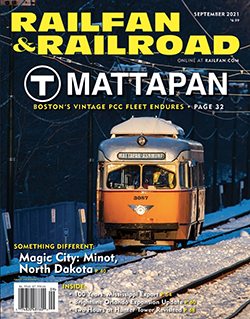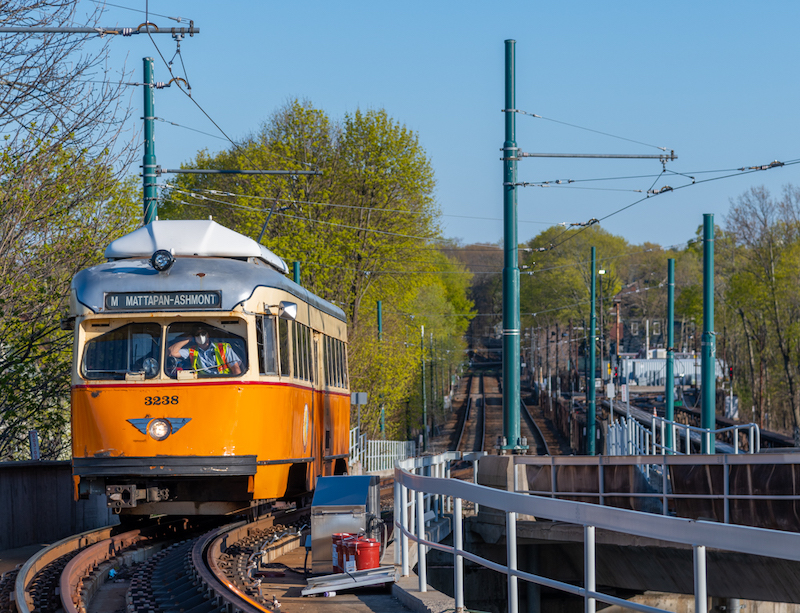 If you ran a trolley, streetcar, or interurban system a century ago, you were probably pretty nervous. All around you, city, county, and state governments were improving streets and roads, all at taxpayer expense. Autos, meanwhile, were getting cheaper and more common; in 1908, a Ford Model T retailed at $850, but by 1924, you could have one for $295. Then there was the bus. Since at least the 1830s, horse-drawn coaches had been used on urban streets as a form of transit, but the internal combustion engine made bus service faster, more comfortable, more flexible, and (perhaps crucially) less stinky than its equine-powered ancestors. City streetcar lines, many using equipment that was 20 years old or older, struggled to respond, and ridership plummeted.
If you ran a trolley, streetcar, or interurban system a century ago, you were probably pretty nervous. All around you, city, county, and state governments were improving streets and roads, all at taxpayer expense. Autos, meanwhile, were getting cheaper and more common; in 1908, a Ford Model T retailed at $850, but by 1924, you could have one for $295. Then there was the bus. Since at least the 1830s, horse-drawn coaches had been used on urban streets as a form of transit, but the internal combustion engine made bus service faster, more comfortable, more flexible, and (perhaps crucially) less stinky than its equine-powered ancestors. City streetcar lines, many using equipment that was 20 years old or older, struggled to respond, and ridership plummeted.
Transit executives felt the solution lay in the equipment; offer riders a better-quality experience, and they’ll come back. In 1929, representatives from about a half dozen operators, as well as a handful of manufacturers, formed the Electric Railway Presidents’ Conference Committee, charged with designing a new streetcar. The new car had to be clean, comfortable, and reliable. Moreover, it had to be modern, exuding the dynamism of the present and the future, not the faded grandeur of the Gilded Age.
The process, supervised by an electrical engineer with no prior vehicle design experience, took almost five years. Four prototypes were unveiled in Cleveland in 1934, and three of the four cars looked like something out of a comic book fantasy of the future. The model “B” prototype, along with two custom versions built for Chicago, shared an aesthetic that recalled cutting-edge aircraft of the day. Inside as well as out, edges were smoothed over and rounded off. Lighting and interiors were bright and clean, seats were well-cushioned and upholstered with smooth vinyl — no more creaky wicker and cane. Named for the committee that designed them, the cars received the acronym “PCC,” and a classic of North American vehicle design was born.
The PCC can best be understood alongside its intercity rail equivalent, the streamliner. Like the Union Pacific M-10000 or the more famous Burlington Zephyr (both from 1934 as well), the PCC was a radical redesign that combined aesthetic and pragmatic changes. Put into production in 1936, the PCC was less a single design than a series of components and associated patents made available for widespread adoption. The all-steel cars were lighter, stronger, and more easily maintained. Their streamlined style, meanwhile, changed public perception. Sure, you might still ride a trolley to visit your grandmother, but thanks to the PCC, you no longer rode there on your grandmother’s streetcar.
Did the PCC work? New cars certainly helped stem ridership losses, and streetcars remained the backbone of urban mobility during the Great Depression and World War II. But was it enough to stem rising automobile ownership, to fix the financial structures of transit operators, or fight off suburbanization? Not at all. These larger issues continued to have great impact. Most operators, seeking to save money, converted to bus operations by 1960, but even this was not sufficient to stem financial losses. By 1970, transit in almost every major metro area was provided by public agencies, not the private for-profit companies of years past.
Yet now, in the third decade of the 21st century, vintage PCC cars remain in service across the continent. They have been rebuilt, often more than once. They may have changed cities a time or two. They might carry tourists on nostalgia lines, but they also still carry commuters on their way home and students on their way to school. A design now nearly a century old still seems, oddly, modern. To know them is to love them, and thanks to public adoration, the PCC is here today.
—Contributing Editor Alexander Benjamin Craghead is a transportation historian, photographer, artist, and author.



